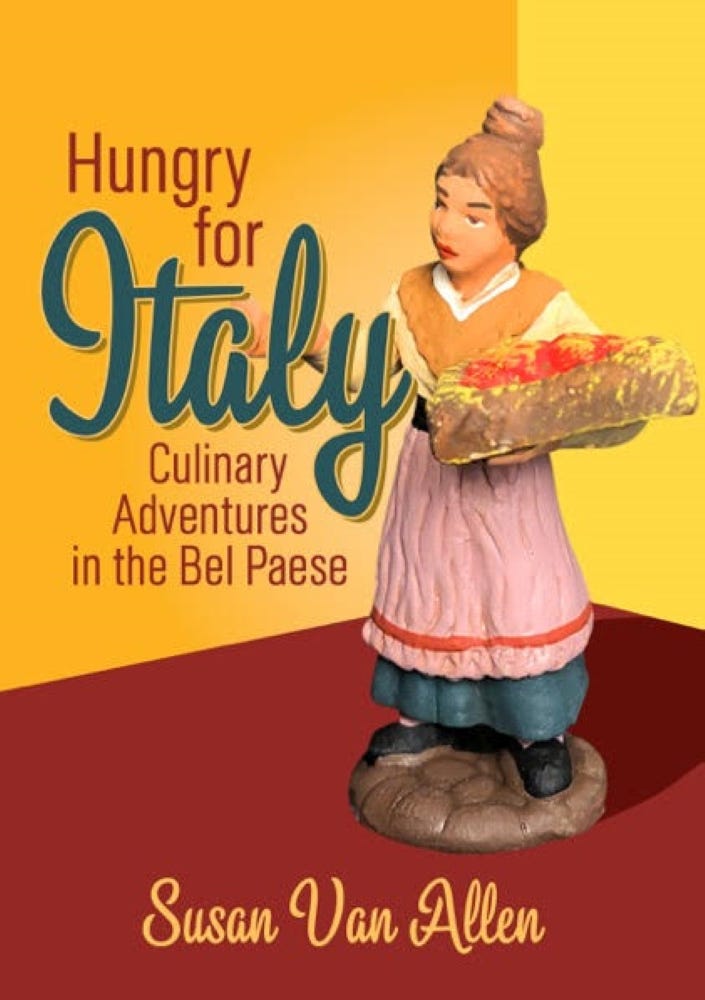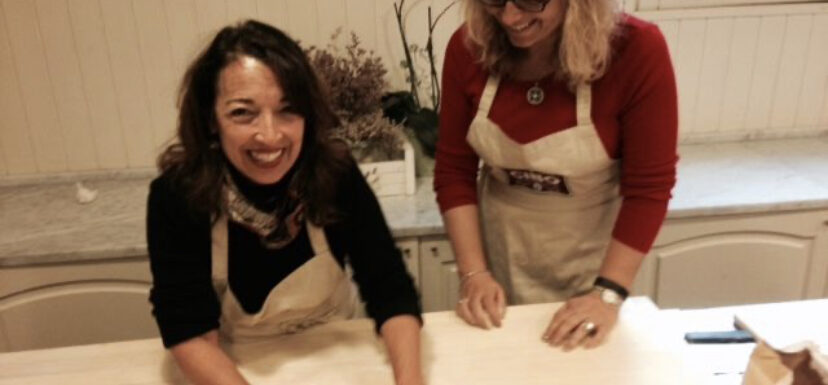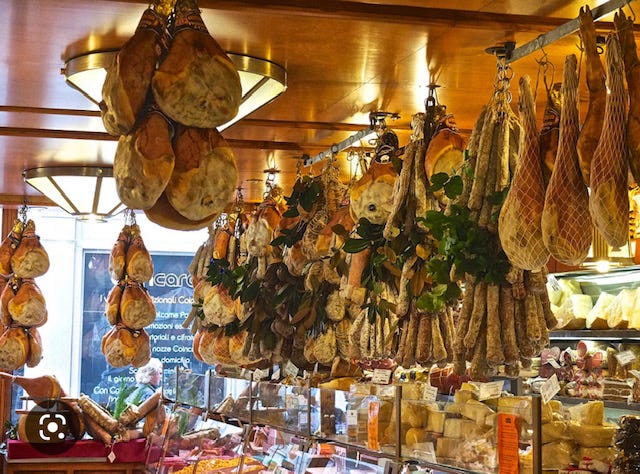
It smells good in here: high note of nose-tingling parmigiano, base of salty cured salumi, and centering it all is rich meaty ragu, the sauce this city of Bologna is famous for. Here in Bologna’s Quadrilatero (market area), I’ve entered the Tamburini shop — a temple of deliciousness that’s been beloved and family run since 1932. I was lured in by window displays of humongous hanging prosciutto, balsamic vinegar in curvy bottles, honey-colored rounds of cheese.
I line up behind a gang of teenagers on their school lunch break, grab a plastic tray to slide along the counter and order what everybody else is having: a heaping plate of tagliatelle. With a tumbler of vino rosso, I take a seat at a tiny wooden table and lean in for a warm inhale. Certainly I won’t finish all this pasta, I’m thinking. After one bite that thought is gone, eclipsed by a euphoric haze . . . What is going on with this sauce?
I’ve long believed I knew my Bolognese, what they simply call ragu here in Bologna. For decades I’ve been dedicated to a Marcella Hazan recipe that’s impressed many guests. But in Bologna, where this beloved specialty was born, I’ve met a different taste.
“Where’s the tomato?” I ask Lucia, my cooking teacher, at CIBO-Culinary Institute of Bologna. I’ve signed up for a pasta making class, and the first order of business is making the ragu. “No, no, it’s not about the tomato. Here in Bologna, it’s all about the meat,” she says. “Ragu should be brown.”
It’s a lightbulb moment. My Bolognese, that I’ve been so proud of “perfecting”, has never been brown. And like many Italian-Americans, I hold a strong sense of “I’ve-Got-The-Best-Sauce” righteousness. I grew up with a mother who followed her southern Italian mother’s tradition — to “make-a-the-ragu” Neapolitan style — red plum tomatoes with chunks of beef, pork, and veal, or meatballs and sausage that simmered all Sunday morning. Before I even knew how to read, I knew this was the best in the world.
As for that red Ragu in a jar, that filled supermarket shelves of my childhood, I joined my mother in shuddering over the sight of it. I pitied neighborhood kids who didn’t have Italian roots, whose moms would pour what we called “Rag-uck” onto their spaghetti. It was thrilling for me to take this stand, my first nose-in-the-air rush at being a snob, at the age of seven.
I carried my treasured Italian sauce snobbery into adulthood, when I set up my own kitchen. Thanks to Marcella Hazan’s cookbooks, I expanded my southern Italian repertoire, including how to make Bolognese, taking great pride in the hours it took to cook, reveling in the sighs it inspired in guests.
And now I’m discovering that except for the slow cooking, real Bolognese ragu is a different thing all together. It’s so thick and rich, it’s considered more of a condimento than a sauce.
The name comes from the Renaissance French ragout (meat stew) inspired by the verb ragouter=to excite the appetite. Northern Italians adapted it to ragu, and it was a peasant dish made from a mix of vegetables from their garden and beef scraps. The first meat sauce is proudly reported to have been made in the late eighteenth century in Imola, a town near Bologna.
In 1891, the grandfather of Italian cooking, Pellegrino Artusi, self-published The Science of Cooking and the Fine Art of Dining, with a recipe for Ragu alla Bolognese that included such rich ingredients as porcini mushrooms and liver. Over the years, Bologna became nicknamed La Grassa (The Fat), for its rich cuisine: stuffed pastas, cured meats, and this ragu. Chefs all over the city each claimed their ragu was the definitive one, inspiring the Italian Academy of Cuisine in 1982 to step in and register a Classic Bolognese recipe with the Chamber of Commerce. Their official ingredients include pancetta, white wine, and milk.
Here in class, Lucia, dressed in crisp chef whites, stylishly coiffed in that fabulous, perfect northern Italian way, takes me through her ragu process. It’s milk-less, with just a few spoons of tomato, like the whisper of vermouth in a martini. Cooking begins with soffrito — a traditional mix of minced onions, celery, and carrot sautéed for a base. Then we mix in the ground meat, spoons of tomato, a ladle of stock that’s bubbling away in a nearby pressure cooker.
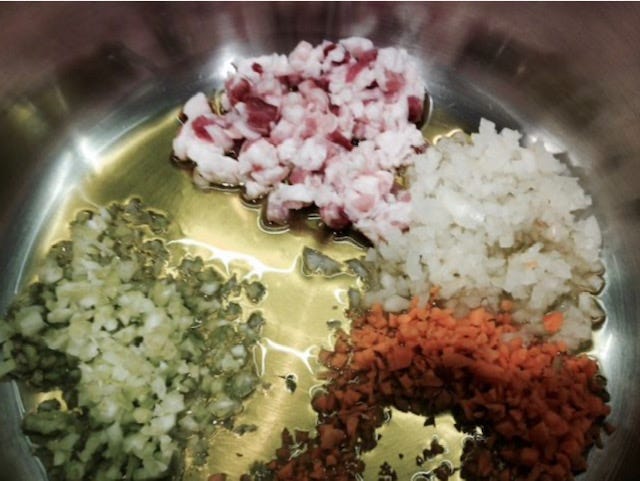
And so begins the slow creation, keeping a careful eye on the pot, adding stock a little at a time — piano-piano (slowly-slowly), as it’s absorbed into the meat.
We move on to pasta making, mixing bright orange egg yolks into a mound of soft flower, kneading till it’s smooth and stretchy. Then Lucia hands me the mattone (giant wooden roller) to make tagliatelle (flat, fettucine-like pasta) — the only pasta that should be eaten with ragu, she says.
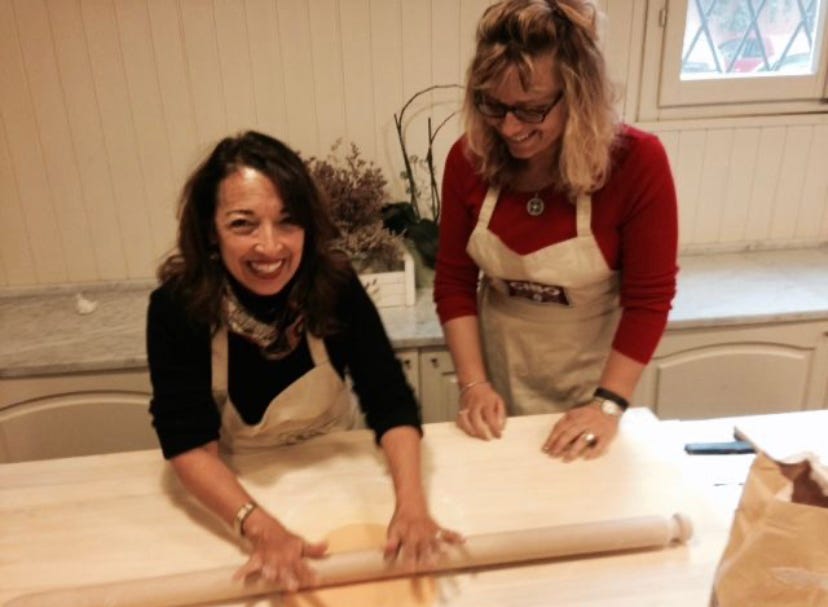
I fall into a soothing rhythm at the table, Lucia leaning in and directing me to rotate the dough circle, as I work the mattone with steady pressure, moving my hands from inside to outer edges. The dough gets thinner and thinner, as the ragu’s aroma gets stronger and stronger, filling the kitchen with deep warmth.
My mind drifts beyond the kitchen to the city surrounding me. Bologna’s not stunningly beautiful like Rome, Florence, or Venice. It has an understated elegance — brown-brick, medieval towers, porticoed sidewalks. My wanderings on those sidewalks have been accompanied by Mozart concertos, casually set up by students from the Accademia Filarmonica.

Before class, I’d slipped into the Basilica of San Stefano, a complex of what was seven churches, a mix of Gothic-Romanesque architecture. Alone, in its deep interior, I stood in a cloister where the poet Dante once meditated. It’s surrounded by sculpted columns of twisted, grimacing figures — the creepy-comic medieval world that inspired the poet’s Purgatorio punishments. Winner for most bizzare is a man with his head turned backward so it sits above his rear.
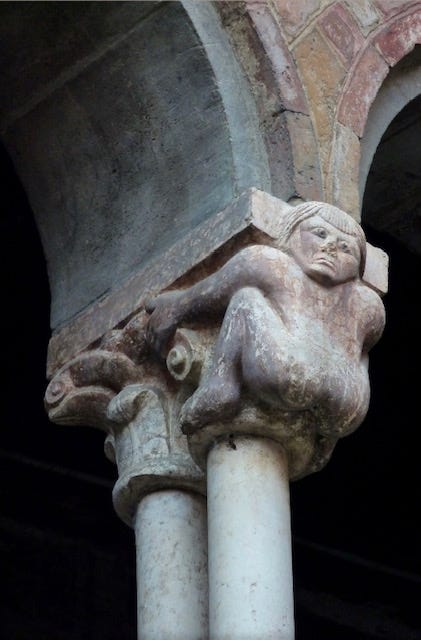
And there’s another that impressed me: a man bent, crushed by a boulder. This eternally burdened and bowed figure gave Dante the idea for his punishment for what he considered the deadliest of the seven sins: Pride.

The vision of that bent guy strikes me again in the cooking class, rolling the mattone, the smell of ragu permeating my whole being. Here I am, bent, my pride deliciously shattered. Bologna has gently humbled me, given a kind and delicious nudge to the Sauce Snob that lived inside of me for so very long.
Now I’m in Paradiso. I raise the mattone draped with dough that I’ve rolled so thin, I can see through it, to the window across the room. A Brava! moment.
It’s been four hours since we’ve begun this Bolognese process. In my other life, I hate slowness — stuck in traffic jams, waiting in DMV lines, writing assignments that take too damn long. But here in this kitchen, slowly cooking is a joy — like a slow dance, a good read, a conversation that lasts till dawn.
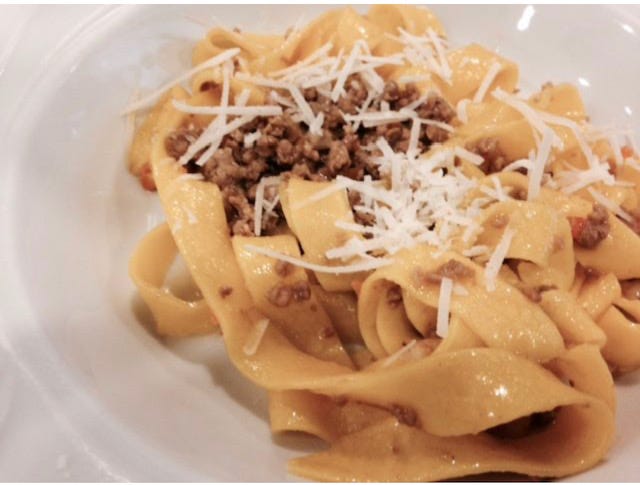
A steaming bowl of pasta alla Bolognese is set before me. I inhale The Real Thing, and dig into the deliciousness, slowly, humbly, savoring every brown forkful.
Favorite Places for Bolognese Ragu
Tamburini
Via Caprarie 1
051 234 726
Excellent deli and wine bar, where you can elbow in with the locals for self-serve traditional specialties
www.tamburini.com
Drogheria della Rosa
Via Cartoleria
051 222 529
This former farmacia, is now a cozy restaurant, beloved by celebrity visitors to Bologna.
www.drogheriadellarosa.it
Cantina Bentivoglio
Via Mascarella 4/b
051 265 416, dinner only
This popular restaurant and jazz club serves great Bolognese classics and features an extensive wine list.
www.cantinabentivoglio.it
CIBO — Culinary Institute of Bologna
Offers cooking classes to teach Bolognese specialties
www.cookingclassesinbologna.com
Ragu, alla Lucia
Serves 4
2 tablespoons extra virgin olive oil
2–1/2 tablespoons butter
1/3 cup pancetta or non-smoked pork belly, minced
2 tablespoons minced onion
1 tablespoon minced carrot
1 tablespoon minced celery
¾ pound ground beef (sirloin is best, or cheaper cuts, such as from the shoulder are okay)
½ cup dry white wine (optional)
2 heaping tablespoons tomato paste
1 pint meat stock, plus 1 cup in case more is needed
1 chicken or rabbit liver, minced (optional)
Put the olive oil and butter into a large saucepan, over medium-low heat. When the butter has melted, add the onion, carrot, and celery. After one minute add the pancetta or pork belly. The vegetables and fat should caramelize, not burn, it should take about 10 minutes. Then add the ground beef, stirring and cooking for about ten minutes.
When the liquid from the meat has evaporated, if you are using wine, add it and stir until it has evaporated. Stir the tomato paste into one cup of the meat broth. Add the mixture to the pot and stir. The color will be brown, not red. Partially cover the pot, and simmer the sauce. When the sauce dries, add a cup of broth and continue to simmer for an hour.
The more you cook your sauce, adding broth a little at a time, the better it will be. Add the second cup of broth gradually, allowing the sauce to absorb it before adding more. Recommended cooking time is 4 hours.
If you are using the liver, add it toward the end of the cooking, and cook for 30 minutes.
This ragu is traditionally served with handmade tagliatelle, cooked al dente.
This is an excerpt from “Hungry for Italy: Culinary Adventures in the Bel Paese”
